You're in the right place if you're looking for a comprehensive Shopify review UK.
Here, I'm digging deep into Shopify's features, pricing, usability, pros, and cons, focusing specifically on its suitability for UK-based businesses.
Quick verdict:
Overall, I think Shopify is an excellent choice for UK merchants pursuing a user-friendly and scalable ecommerce platform with tons of in-built sales features.
- Full solution from $29/month
- Limited time offer: first 3 months for $1/month
- SEO Friendly
- Offline Store
- App Store
- 24/7 Support
- Beautiful Templates
Hopefully, by the end of this review, you'll better understand whether Shopify is the right ecommerce platform (or not!) for your needs.
Shopify is the best ecommerce platform available for UK businesses (at the time of writing). Period. Its ease of use, extensive range of features, and flexible pricing options make it an excellent choice for businesses of all sizes.
Most notably, I love Shopify's intuitive website builder. It allows you to create professional-looking online stores without knowing any coding.
Additionally, Shopify's App Store provides a wealth of opportunities to extend Shopify’s base functionality, allowing businesses to tailor their online store to meet their more precise needs and goals.
Table of contents:
- What is Shopify?
- How Does Shopify Work in the UK?
- Shopify Pros and Cons for UK Users
- How Did We Test Shopify in The UK?
- Critical Differences for Shopify UK Users
- Shopify Review UK: Shopify Pricing
- Shopify Fees
- Shopify Payments
- Shopify’s Key Features
- Shopify App Store
- Shopify Retail Solutions / POS
- Selling Digital Products with Shopify
- Selling Globally With Shopify
- Shopify Review UK: Dropshipping on Shopify
- How Easy is Shopify to Use?
- Shopify Review UK: Customer Support
- Shopify User Reviews from the United Kingdom
- Top Alternatives For Shopify in The UK
- Shopify Review UK: My Final Thoughts
That’s enough preamble! Let’s dig into the meat and potatoes of this review, but first:
What is Shopify?
For the uninitiated, Shopify is an all-in-one eCommerce platform that provides a plethora of tools so businesses of all sizes can create and manage their online stores.
It also offers powerful POS (point of sale) software, enabling you to manage your in-person and online sales efforts in unison.
As a cloud-based SaaS, users worldwide can benefit from Shopify’s offering (including UK merchants). Some of Shopify’s most notable hallmarks include its website building, payment processing, shipping, and inventory management features.
Shopify use is snowballing among small to medium-sized UK businesses due to its ease of use and flexibility.
In fact, as of 2022, UK Shopify stores have seen a 41% rise in popularity year on year – and there's a solid reason behind its rocketing growth: more than 50 million buyers purchased from Shopify merchants in 2022 alone, typically spending over £84 per purchase.
The moral of the story? Shopify provides the tools entrepreneurs need to create high-converting ecommerce stores.
How Does Shopify Work in the UK?
Following these steps, you should get your Shopify store up and running relatively quickly:
Step 1: Create a Shopify Account
Create an email account by typing in your email address, adding a password, and a store name (you can change this later).
Click “Create Store,” and you’re taken to a page-by-page walk-through of the details Shopify needs. Typically, Shopify offers a free trial, although these vary.
Step 2: Setup Your Store
You’re then taken to your dashboard, from which you set up your store. From your dashboard, you can manage all aspects of your store, including adding products and their descriptions, choosing your Shopify theme, processing orders, setting up payments, generating marketing campaigns, and more.
Step 3: Customize The Theme
Once you’ve chosen your theme, you can customize it using the WYSIWYG page builder. Shopify has a helpful video for you to watch on how to do this.
Step 4: Add Your Domain
Add your domain by going to your dashboard and clicking “Add Domain.” If you have one already, you can transfer it to Shopify, or if you haven’t, you can buy one via Shopify.
Step 5: Setup Payments
Configure your payment settings from your dashboard by simply clicking “Set up payments.”
Step 6: Publish Your Store
Your website won’t go live until you’ve chosen your pricing plan and published it.
Shopify Pros and Cons for UK Users
One of the main benefits Shopify unlocks for UK merchants is the ability to sell globally, as Shopify supports multiple currencies and languages. It accepts 130 currencies across 75 countries and supports 20 languages.
However, Shopify’s transaction fees are somewhat of a drawback (more about these fees below).
With that said, here's a quick overview of Shopify UK’s most notable pros and cons:
Shopify Pros 👍
- You can offer customers 100+ popular payment options, including PayPal and Stripe.
- Shopify comes with a range of in-built marketing features, including SEO tools, social media integrations, and marketing automations such as a welcome email or upsells using ready-to-use templates.
- Shopify’s customer service includes 24/7 live chat, phone, and email on all Shopify plans.
- Shopify users get access to easy-to-use and mobile-responsive website design tools, including 120 professionally designed themes, of which 11 are free.
- Shopify’s App Store is extensive – there’s an app for near-on anything you can think of.
Shopify Cons 👎
- Since there's so much to offer, there's a slight learning curve.
- If you don’t use Shopify Payments (Shopify’s native payment gateway), you’re charged an extra transaction fee. This rate varies depending on which price plan you’re on.
- If you don’t keep an eye on your budget, some of Shopify’s add-ons, like apps and premium themes, can get pricey.
How Did We Test Shopify in The UK?
For the last 6 years, I have tested and reviewed various ecommerce platforms, and I can confidently say that Shopify is one of the best options available. Since I live in the UK, it's also easier for me to better understand the
Here's why:
To be able to write accurate eCommerce-related content, I’ve made it my business to keep an eye on Shopify-related news, updates, and reviews (as has the rest of the ecommerce Platforms team), and it’s fair to say that this ecommerce solution stands out against competitors time and time again.
In fact, the ecommerce Platforms team has surveyed and analyzed more than 3,000 online shops on Ecomm.design and found that Shopify was the most popular.
It’s also worth noting that after collectively using and reviewing many online store builders, eCommerce Platforms listed its top ten ecommerce and shopping cart software and created a handy comparison chart, where Shopify, unsurprisingly, came out on top.
Elsewhere, other real-life Shopify users praise the platform for its comprehensive features, ease of use, and superb customer service.
For example, reviewers on Capterra UK give it an overall 4.5/5 rating, while reviews on GetApp hit a 4.5/5.
However, UK Trustpilot UK users are less enthusiastic, with a 1.4/5. Yet, most reviews are more about customer complaints about sellers who use the platform than the platform itself.
All this combined has led the ecommerce team and me to one conclusion:
Shopify is the best eCommerce platform on the market right now.
However, for UK users, there are some key differences to consider when deciding whether Shopify is the right fit for you.
Critical Differences for Shopify UK Users
One significant difference is that some of Shopify's POS hardware, such as the Shopify Tap and Chip Card Reader, POS Go, and Dock, are only available in the US and Canada.
However, the WisePad 3 card reader is available for UK stores, as is a Shopify Retail bundle with a card reader, a retail stand for your iPad, and a charging cable. You can also buy hardware accessories such as a barcode scanner and a Bluetooth receipt printer.
Also, in 2022, Shopify launched Shopify Markets Pro, a premium version of Shopify Markets. Shopify Markets Pro is currently only available to vendors in the US. However, there are plans to roll this out to users in Canada, the UK, and Europe in 2023.
It’s also worth noting that where online payment gateways are concerned, Meta Pay and Afterpay aren’t available in the UK (at the time of writing).
The same goes for the Shopify Fulfillment Network. This program allows Shopify to manage your order fulfillment, freight, storage, and returns. However, this service is only available to sellers operating from the US.
On top of that, as a UK-based seller, you’ll also need to consider the following:
- Taxes: UK merchants must comply with Value Added Tax (VAT) regulations, which can be complex. Thankfully, Shopify provides built-in tax calculations for UK VAT, and you can automatically charge taxes. But you can’t use Shopify to remit or file your taxes. Please note that the merchant is responsible for correctly setting tax rates and exemptions.
- Compliance: UK merchants need to customize their online store to comply with local regulations such as accessibility and GDPR. Although Shopify has dedicated a few self-help resources to these topics, there don’t appear to be in-built features to ensure compliance with GDPR and accessibility regulations. Fortunately, you’ll find plenty of apps in Shopify’s App Store that can help.
Shopify Review UK: Shopify Pricing
Shopify offers several pricing plans for UK merchants, most of which come with two billing options: monthly or yearly.
With annual billing, merchants get a 25% discount on their monthly subscription price. Shopify also offers a 3-day free trial for all plans, so merchants can test the platform and see if it fits their business before committing to a paid plan.
You can start the free trial here.
With that in mind, here's a quick overview of Shopify’s pricing packages:
Starter – 3 months for £1 / mo, then £5 a month
This includes order management, analytics, and a basic Shopify store using the Spotlight theme, where you can customize your logo and brand colors. While it doesn't allow POS integration, it does provide the following:
- A simple storefront
- Unlimited product pages
- Fast and secure checkout
- A contact page for customer inquiries
- A Linkpop page – this drives your social media followers to your top products/content via a link on your social media bio.
- Access to Shopify apps
- 24/7 customer support via email and live chat
- SSL certificate for your site
- A 5% transaction fee (using Shopify Payments)
Basic – 3 months for £1 / mo then £25 a month (£19 a month when billed yearly)
The Basic plan includes all the Starter plan features plus support for two staff accounts; you'll also get the following:
- A fully-fledged Shopify store
- 1,000 inventory locations
- Inbuilt abandoned cart recovery, gift card, and discount code tools
- Basic reports
- You’re charged a 2% + 25p fee for online transactions and 1.7% for in-person transactions (using Shopify Payments)
Shopify – £65 a month (£49 a month when billed yearly)
This includes all the Basic plan features, plus professional reports, which comprise additional reports concerning customer behavior, marketing, orders, online sales, retail sales reports, profit, etc., (not included in the previous plans). In addition, you'll also get the following:
- Free access to Shopify Flow, an automation app that unlocks pre-built automation templates and trigger, condition, and action building blocks to create your own workflows.
- Five staff accounts
- You’re charged 1.7% + 25p online transaction fees and 1.6% for in-person transactions (when using Shopify Payments)
Advanced – £344 a month (£259 a month when billed yearly)
The Advanced plan comes with all the above features, plus:
- 15 staff accounts
- Real-time carrier shipping rates
- A duty and import tax calculator that estimates and collects duties and import taxes at checkout and provides customers with total cost clarity.
- You’re charged 1.5% + 25p online and 1.5% + 0p in-person transaction fees (when using Shopify Payments)
Shopify Plus – Starting at $2000 a month (~£1653)
The Plus plan is a custom package designed for large, high-volume businesses. It includes all the Advanced plan features, plus dedicated support, a custom checkout, and the ability to create multiple storefronts.
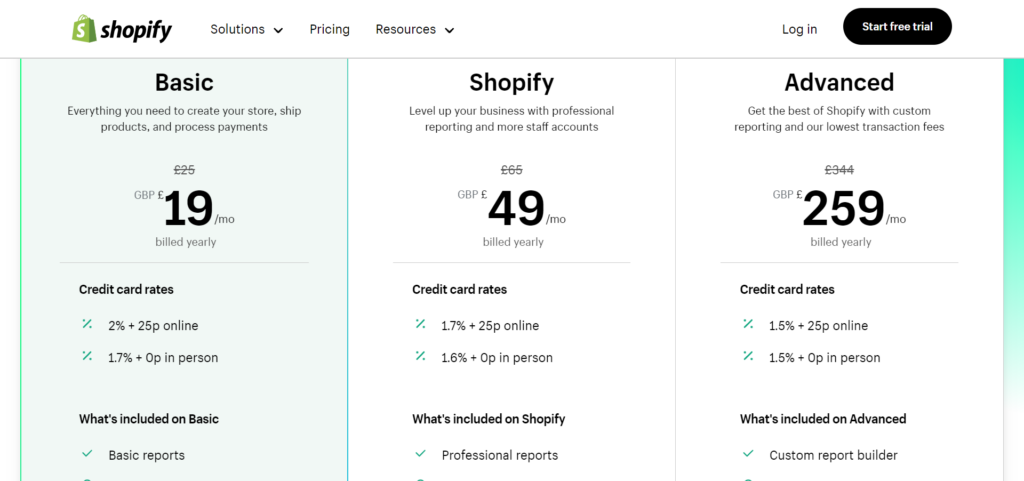
Shopify Fees
As alluded to throughout this review, in addition to Shopify’s monthly subscription fees, there are a few other costs to note:
Transaction fees
For Basic, Shopify, and Advanced plan subscribers, there are different levels of transaction fees when using Shopify Payments.
The more expensive the plan, the less you pay in fees. For example, Advanced plan subscribers are charged 1.5% + 25p for credit card transactions, whereas Basic plan subscribers are charged 2% + 25p per transaction.
As for third-party transaction fees (I.e., when you use a payment gateway other than Shopify Payments), Basic plan subscribers are charged 2% per transaction, while for Shopify and Advanced plan subscribers, it’s 1% and 0.5%, respectively.
Currency conversion fees
These apply when Shopify converts currencies on your behalf and are based on your store's primary country. For the UK, this fee is 2% with Shopify Payments.
Shopify Payments
Shopify offers a range of payment options that make it easy for UK merchants to accept customer payments.
As I’ve already mentioned, Shopify Payments is Shopify’s native gateway and, as such, the option they seem to prefer. It presents a fast and secure way for businesses to accept customer payments without setting up a separate merchant account.
Shopify Payments supports a wide range of payment methods, including Visa, Mastercard, American Express, and Discover, as well as digital wallets like Apple Pay and Google Pay.
For UK merchants that wish to use a third party payment gateway, Shopify also supports this. Popular options include PayPal and Worldpay.
Where UK payment and data privacy regulations are concerned, Shopify Payments fully complies with Payment Card Industry Data Security Standards (PCI DSS), designed to protect customer data and prevent fraud.
Shopify’s Key Features
Shopify has an extensive set of features available for the UK market as well, and although I don’t go into them all below, I’ve picked out some of the standout ones:
Website Design and Shopify Themes
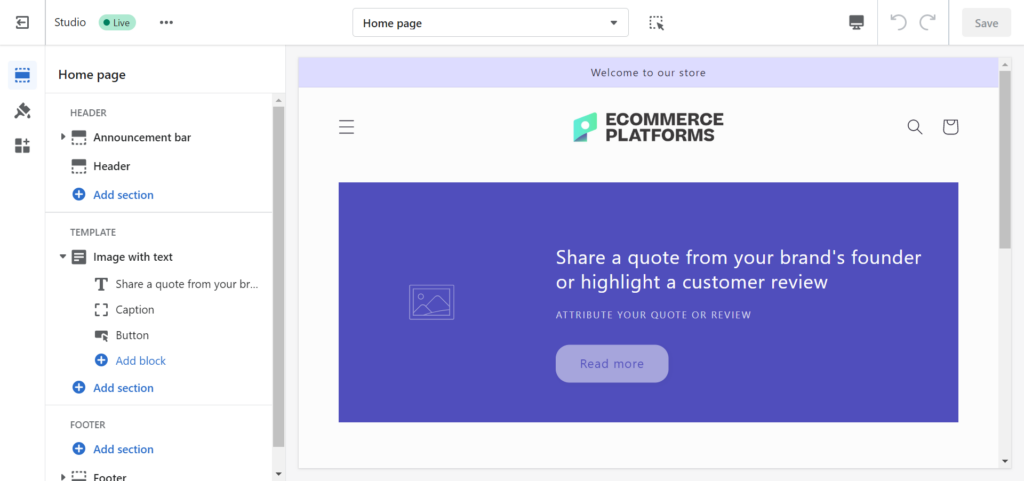
Shopify boasts 120 easy-to-customize and mobile-responsive themes (a collection of free and paid-for).
Shopify's themes come in various styles, from minimalist and modern to bold and colorful. These themes are organized by industry, making it easy for businesses to find a design that suits their brand.
Paid themes range from around £150 to £290. Premium options offer more advanced features like custom page templates and product filtering.
Once you've picked a theme, you can use Shopify’s WYSIWYG website editor to modify the theme's layout, upload images, add text, etc., without knowing how to code.
However, you can add custom CSS and HTML code for more granular customization.
Product and Inventory Management
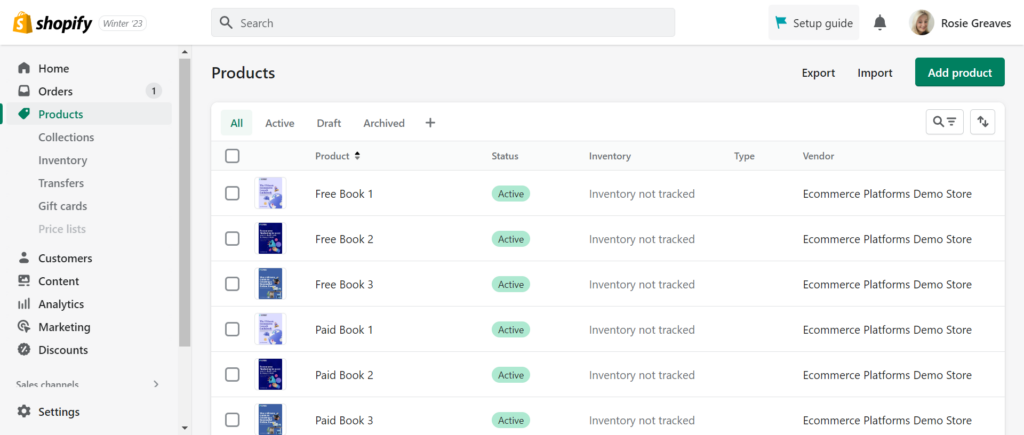
You can add, edit, and organize products, product variants, and collections and upload multiple product images in one go. You can also track stock levels, set inventory alerts, and manage inventory across multiple locations.
You can also see your Shopify inventory’s history adjustments. For example, the date you made the adjustment, the event that caused the adjustment (e.g., an order), unavailable inventory after you made an adjustment, and more.
Marketing
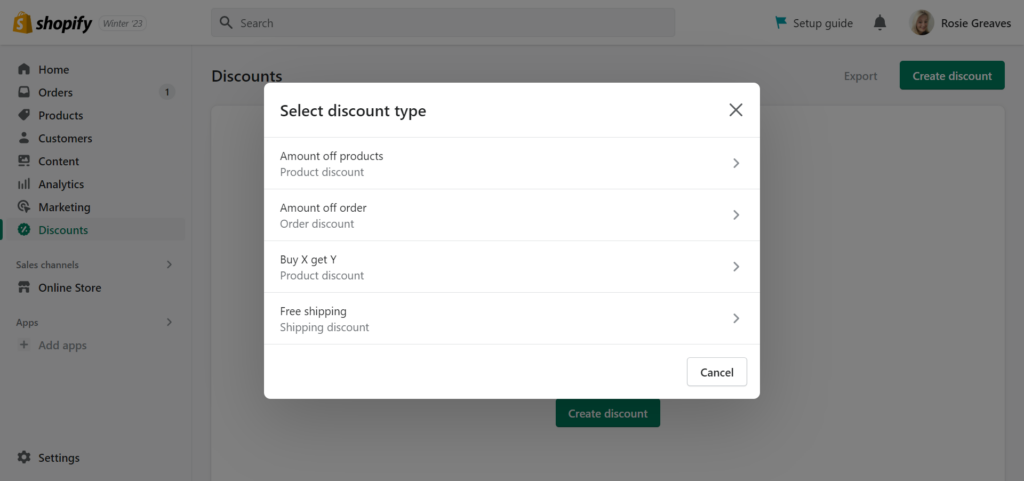
Shopify offers a range of in-built marketing features, including:
- Creating and managing email campaigns (Shopify users get access to various email templates and can segment their audience to launch more targeted messages. You can also automate email campaigns based on specific triggers or events).
- Social media advertising via Facebook and Instagram. You can automatically sync your Shopify products with both social platforms and offer customers the option to checkout without them having to leave Facebook or Instagram.
- Search engine optimization- including being able to edit meta descriptions, title tags, web page URLs, and so on. You can also use Shopify’s blogging feature to drive traffic to your store.
- You can create and sell gift cards customized with different designs and messaging.
- You can bundle products together to market a more enticing offer.
- You can upsell/cross-sell complementary or related products to customers at checkout or via email.
- Shopify supports multichannel selling on platforms like Facebook, Instagram, Amazon, eBay, etc.
Analytics
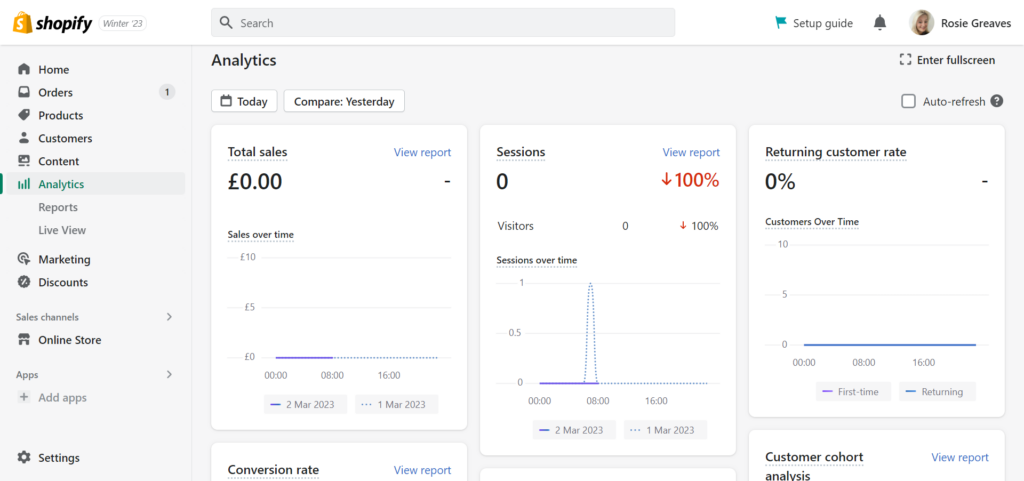
Shopify offers a range of analytics features to help businesses track their performance and make data-driven decisions.
For starters, Shopify provides an overview of your key real-time performance metrics. These include sales, traffic, and orders.
You can also utilize a range of customizable analytics widgets and data visualizations to help pinpoint data pertinent to your operations and better identify trends.
As I’ve already alluded to, Shopify offers a range of pre-built reports, including sales, customer, and inventory reports, and more. Shopify also allows you to create custom reports using various filters and dimensions.
Orders and Shipping
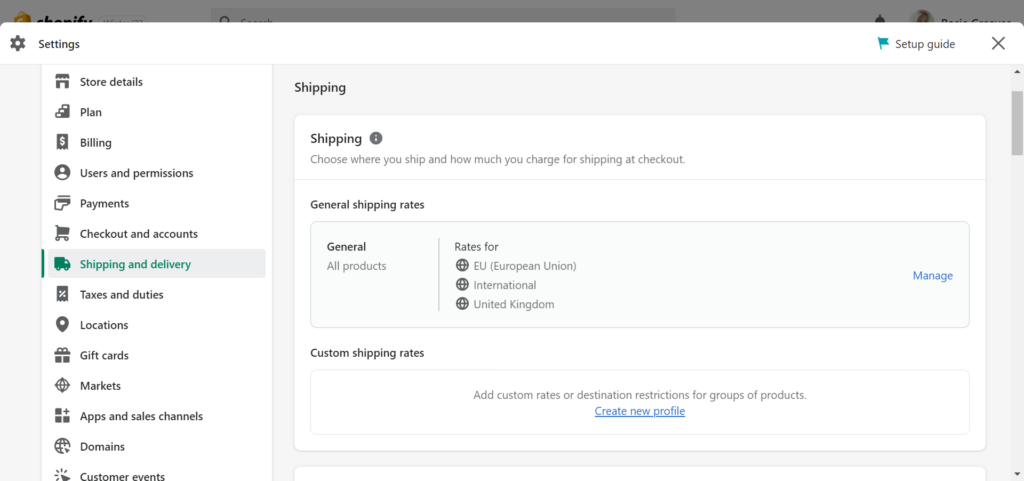
You can manage, edit, cancel, fulfill, and refund orders from a single dashboard.
Shopify users can also customize and automate their order confirmation emails and shipping updates to keep customers abreast of their order status.
As for shipping, you can:
- Print shipping labels via Shopify
- Set shipping zones and corresponding rates
- Offer free shipping promotions.
- Integrate with popular shipping carriers, including UPS, DPD, FedEx, and Hermes.
Shopify App Store
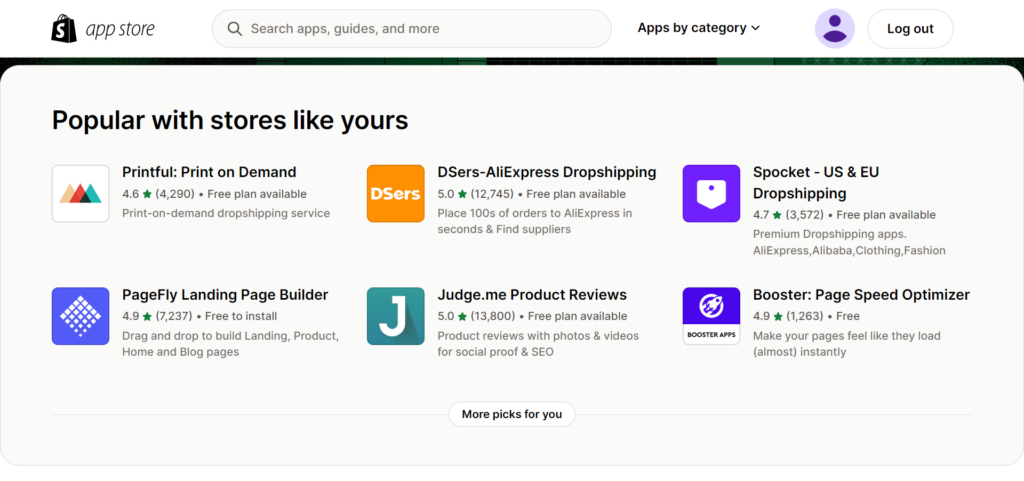
As previously mentioned, on Shopify’s App Store, you’ll find over 6,000 apps designed to enhance Shopify's base functionality. There are apps for all kinds of purposes, including inventory management, shipping and fulfillment, marketing, accounting, and more.
Of course, these apps come at different price points. Some are free, and others offer a limited freemium plan or a free trial. In contrast, others demand a one-time upfront cost or subscription plan.
The Shopify App Store is continuously growing, with new apps added regularly to meet the changing needs of eCommerce businesses. With so many options, you’re sure to find the apps best suited to your needs.
Shopify Retail Solutions / POS
Shopify's retail solutions and POS offerings provide a range of options for businesses to manage their in-store transactions and track their inventory in real time.
One of Shopify's popular POS offerings is its mobile POS system. It enables merchants to process payments in-person and track their inventory via their mobile devices, making it a great option if you’re selling at trade shows, pop-up stores, etc.,
There are two main POS packages to choose from:
- The POS Lite package (included with all Shopify plans)
- The POS Pro package ($89 per month, per location).
POS Lite offers a comprehensive range of features, including support for customer profiles, mobile POS, and order and product management.
In contrast, POS Pro includes additional functionality, such as advanced inventory management and analytics support, staff accounts, and omnichannel selling features.
Read our full comparison here: Shopify POS Lite vs. Shopify POS Pro – What's the Difference?
*For more details about POS hardware, scroll back to the ‘Key Differences for Shopify UK Users’ section.
Selling Digital Products with Shopify
Shopify offers many features specifically designed to support digital product sales. For instance, you can upload digital products and create download links that are delivered to customers automatically once a purchase is made.
However, selling digital products comes with its own set of challenges, such as managing license keys, protecting intellectual property, and ensuring downloads are kept secure.
To address these hurdles, Shopify supports a range of third-party apps that can help merchants manage their digital products more effectively. For example, EDP and Downloadable Digital Assets.
Selling Globally With Shopify
Shopify offers UK merchants an easy way to sell globally. With a Shopify store, UK merchants can easily manage and track international orders, shipping rates, taxes, and currencies.
Shopify makes creating and managing international storefronts reasonably straightforward. For example, you can create storefronts for different regions translated into their own language and use their native currency via a subdomain.
This makes it easier to target specific markets and improve the customer experience.
Shopify also supports a range of international payment options, with over 100 payment gateways supported. This ensures merchants can accept payments from customers in different countries and currencies, making it easier to grow internationally.
Shopify also integrates with leading shipping carriers and logistics providers worldwide, making managing and tracking international shipments easier and providing customers with real-time tracking information.
Shopify Review UK: Dropshipping on Shopify
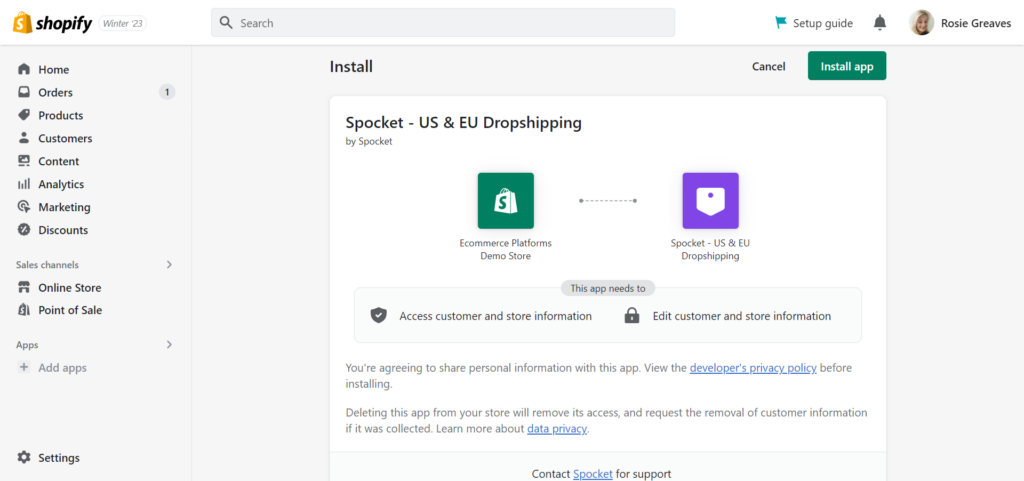
Suppose you're a UK merchant looking to start dropshipping with Shopify. In that case, you'll be glad to know that Shopify offers a range of features to help you get started quickly and easily.
For instance, you can browse the Shopify app store for dropshipping apps to help you source dropshipping suppliers. Some of the best dropshipping apps include Spocket, Modalyst, and AliExpess.
Different dropshipping apps boast different features. However, many of the dropshipping apps Shopify integrates with include the following:
- Product sourcing
- Automated order fulfillment (once a customer places an order on your Shopify store)
- Real-time inventory syncing
Shopify's general online sales features are also immensely helpful for managing a dropshipping store. For example, setting up custom shipping rules and automatic order tracking.
Also, to ensure smooth and secure transactions, you can use Shopify's built-in payment gateway or integrate with popular payment providers like PayPal. All these features combined mean that Shopify provides a centralized place for you to oversee your dropshipping venture.
How Easy is Shopify to Use?
Shopify is one of the most user-friendly eCommerce platforms available.
Shopify’s interface is clean, intuitive, and very easy to navigate. In addition, the dashboard is well-organized, with all its features clearly labeled and easy to find.
Shopify is also fully hosted in the cloud, meaning users don't have to worry about finding their own web hosting, server maintenance, or manually installing platform upgrades.
Shopify Review UK: Customer Support
Shopify offers a variety of resources to help UK merchants. To give you an overview, you'll find:
Help Center: Shopify's Help Center is an extensive online knowledge base covering step-by-step tutorials, videos, and FAQs on topics like setting up your store and managing orders and payments.
The Help Center is accessible 24/7 and is an excellent self-help resource for finding quick answers to your questions.
Community: Shopify's Community is a forum where merchants can connect, share advice, and discuss topics related to running an online store. You can post questions, browse through existing threads, and network with other Shopify users.
Blog: Shopify's Blog is a resource for Shopify and eCommerce news, updates, and advice. It covers topics such as marketing, design, and industry trends.
Support: Shopify offers 24/7 customer support via phone, email, and chat to UK merchants on all plans. Merchants can contact Shopify's support team to get help with technical issues, billing questions, and other concerns. The highly responsive support team provides fast, helpful solutions to merchants.
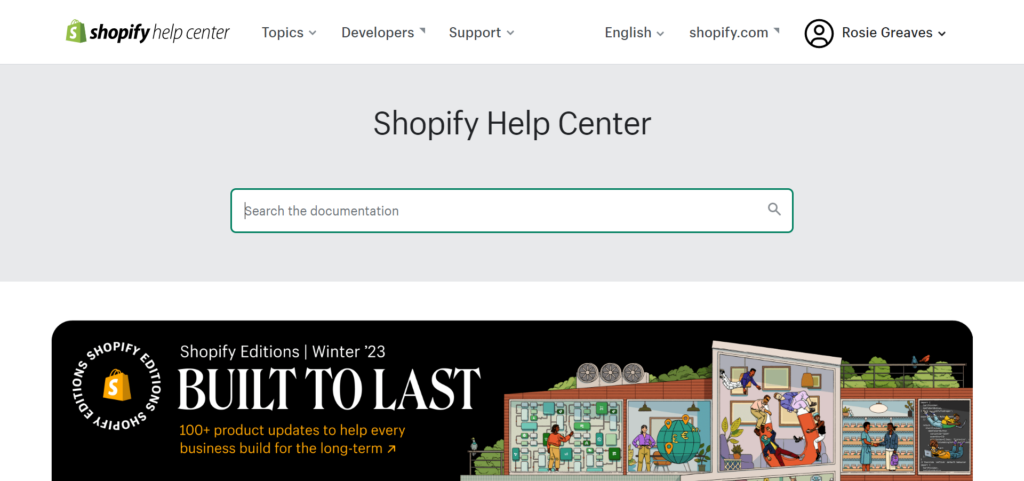
Shopify User Reviews from the United Kingdom
While there are many reasons to use Shopify, the actual users should have the final say. So, we've compiled a few ratings from popular review forums to do just that – including GetApp, G2, and Capterra; more specifically, we’ll look at how they’ve ranked Shopify’s following aspects:
- Overall performance
- Ease of use
- Customer support
- Features
- Value for money
Overall Performance
- G2 – 4.4 out of 5 stars
- Capterra – 4.5 out of 5 stars
- Getapp – 4.5 out of 5 stars
Ease of Use
- G2 – 8.5 out of 10
- Capterra – 4.5 out of 5 stars
- Getapp – 4.5 out of 5 stars
Customer Support
- G2 – 8.5 out of 10
- Capterra – 4.4 out of 5 stars
- Getapp – 4.4 out of 5 stars
Features
- G2 (n/a)
- Capterra – 4.4 out of 5 stars
- Getapp – 4.4 out of 5 stars
Value for Money
- G2 (n/a)
- Capterra – 4.3 out of 5 stars
- Getapp – 4.3 out of 5 stars
Top Alternatives For Shopify in The UK
Now, if for some reason I haven't got you wholly sold on Shopify, below I’ve listed some alternatives worth considering:
Squarespace – Best Shopify alternative for Small Business
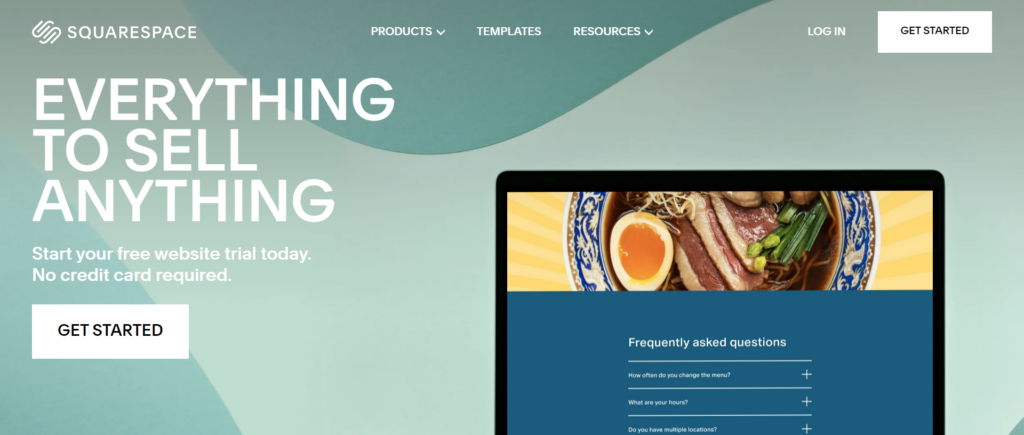
Pricing: £16 to £43 a month
Squarespace is predominantly a website builder that also offers eCommerce functionality. It's known for its visually appealing templates and ease of use, with over 230 customizable themes to choose from.
However, compared to Shopify, Squarespace’s eCommerce offering is weaker. For example, unlike Squarespace, Shopify has many more dropshipping apps, more sophisticated inventory management, a greater number of payment gateways, and more advanced POS – to name but a few examples.
But Squarespace does offer all the essentials for building and running a beautiful-looking online store. Its pricing is similar to Shopify but doesn't charge transaction fees from its mid-tier plans onwards.
Squarespace's key features include its easy-to-use website editor, flexible layouts, custom color palettes, Google and TypeKit fonts, free high-quality images from Unsplash, built-in photo editing capabilities, built-in SEO tools, a user-friendly interface, etc.,
Further reading 📚
Wix – Best Shopify Alternative for Beginners

Pricing: £15 to £27 a month
Wix is another website builder that offers eCommerce functionality. It's a popular choice for small businesses and individuals due to its affordability and incredible ease of use.
Compared to Shopify, Wix provides more design flexibility but fewer payment options. For instance, with Wix, you get a whopping choice of over 800 theme templates and an intuitive 100% drag-and-drop website builder. However, where payment gateways are concerned, it only offers Paypal and Wix Payments.
It’s also safe to say that Wix is better designed for smaller eCommerce stores. For example, Wix’s inventory management is more limited compared to Shopify. Also, unlike Shopify, you’ll have to download and use apps from Wix’s app marketplace to benefit from things like revenue reports and visitor analytics.
Its pricing is similar to Shopify's, but Wix charges a flat transaction fee of 2.1% for UK merchants.
Other key features include the following:
- Wix ADI (where AI creates a unique website for you in just a few minutes)
- Built-in SEO tools.
- An in-built blog
- Appointment booking
- You can list unlimited products
- Cart abandonment functionality
…and more!
Further reading 📚
BigCommerce – Best Shopify alternative for mid to large business
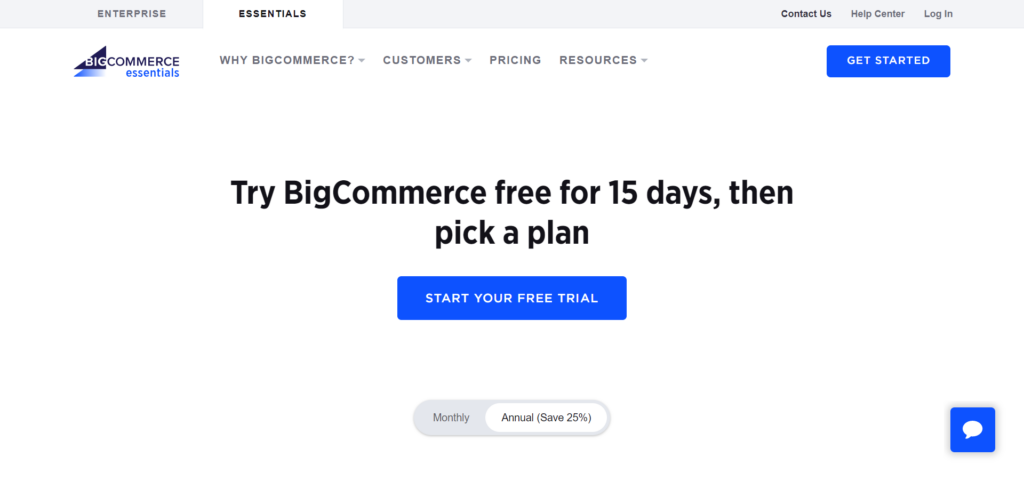
Pricing: £22 to £233 a month
BigCommerce is an eCommerce platform best known for its scalability and robust features. It has 170 customizable templates and great built-in marketing tools, including custom product recommendations.
Compared to Shopify, BigCommerce offers more B2B-specific features (bulk pricing, custom price list, and more) and checkout customization (the latter only becomes available with Shopify’s enterprise package).
However, BigCommerce is pricier than Shopify. Other key BigCommerce features include:
- A drag-and-drop editor
- Built-in SEO tools
- Single-page checkouts
- Multichannel sale support
- Multi-currency support
- You can list unlimited products
- Customers can leave ratings and reviews
…and more!
Further reading 📚
Square Online – Best for Simplicity
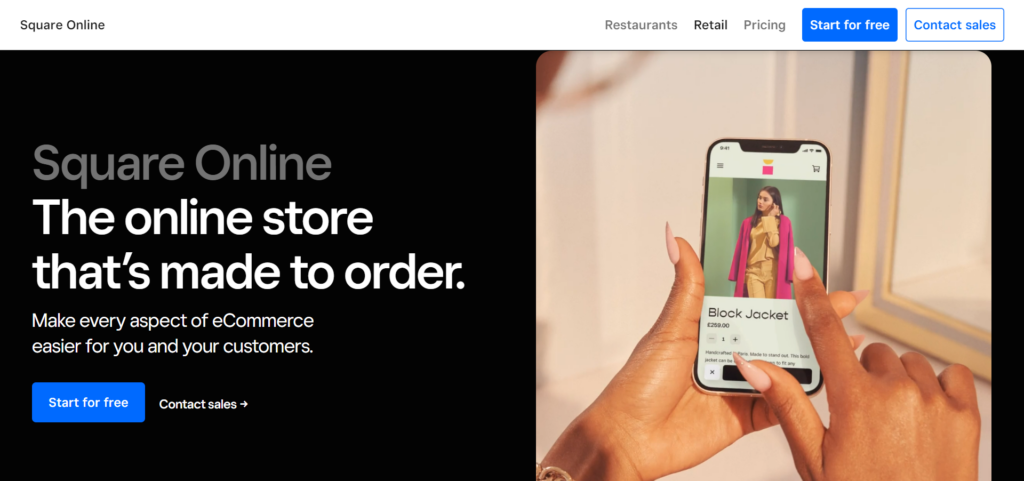
Pricing: Free to £54 a month
Square Online is a newer eCommerce platform geared more toward small businesses. It's known for its simplicity and affordability. Compared to Shopify, Square Online offers fewer features overall but more straightforward pricing (including a free plan).
Its key features include:
- Customizable templates.
- A drag-and-drop editor.
- Built-in SEO tools.
- Shipping and order management features.
- Its own POS system.
Unfortunately, its ease of use comes at a cost: Square Online’s design functionality is severely limited because it has far fewer customization options. Plus, there are only nine integrations within its app store, so depending on your ambitions, you may quickly outgrow Square Online.
Further reading 📚
Ecwid – Best for Low Prices
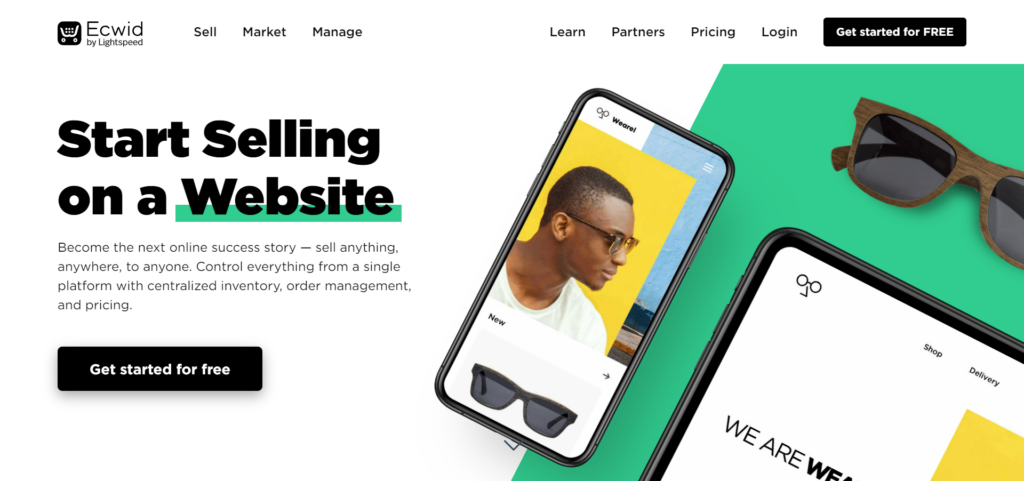
Pricing: Free to £99 a month
Lastly, Ecwid is an eCommerce platform known for its ease of use. Compared to Shopify, Ecwid offers a lower price point (again, it has a free plan) and doesn't charge extra for using third-party payment gateways.
Ecwid also offers headless eCommerce capabilities, meaning you can start selling using Ecwid from your existing website/blog. That said, its eCommerce features could be more extensive. For instance, you can’t edit product URLs or create redirects, which isn’t great for SEO. Plus, its app market is pretty small, so expanding upon Ecwid’s base functionality is pretty difficult.
Ecwid's key features include customizable templates, a drag-and-drop editor, built-in SEO tools, and GDPR compliance.
Further reading 📚
Shopify Review UK: My Final Thoughts
With its well-organized dashboard, extensive self-help documentation, beautiful templates, and flexible pricing plans, Shopify provides businesses of all sizes with the tools they need to create and scale their online stores.
Best of all, its huge app store makes expanding Shopify’s base functionality easy!
That’s enough from me, what do you think? Let us know in the comments below!





Comments 0 Responses